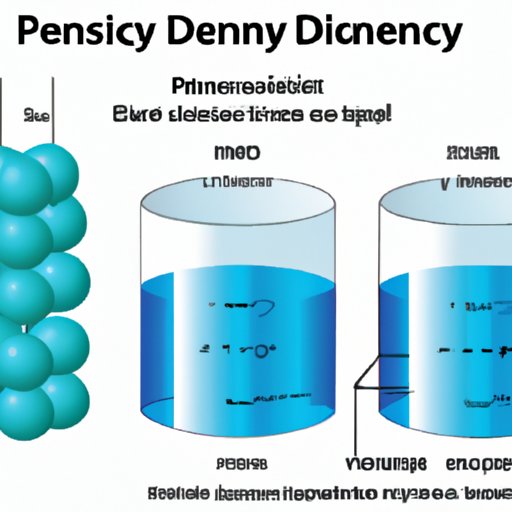
Introduction
Have you ever wondered why some objects float while others sink? Why some substances are easier to compress than others? Understanding density is the key to answering these questions. Density is a property commonly discussed in both physical and chemical sciences. However, it can be confusing to know whether density is a physical or chemical property. In this article, we will explore the basics of density and dive deeper into how it relates to both physical and chemical properties of substances.
The Basics of Density: Understanding It as a Physical Property
Density is defined as mass per unit volume. It is a physical property since it can be measured and observed without changing the chemical identity of a substance. Common units for measuring density are grams per milliliter (g/mL) and kilograms per cubic meter (kg/m³). The density of a substance can be calculated by dividing its mass by its volume, as shown in the following formula: density = mass ÷ volume.
Density plays a crucial role in physical science. It helps us understand how different materials interact with each other. For example, density can explain why oil floats on water. Since oil is less dense than water, it rises to the top. Density is also used in determining the buoyancy of objects and in the study of fluid dynamics.
Density as a Chemical Property: Exploring its Relationship with Atomic Structure
While density is primarily a physical property, it also has relevance in chemistry. To understand this, we need to explore the relationship between density and atomic structure. Atoms are composed of protons, neutrons, and electrons. The number of protons in the nucleus determines the element, while the number of neutrons can vary to form isotopes of the same element.
The molecular mass of a substance is determined by adding up the masses of its constituent atoms. Since density is mass per unit volume, it is affected by the molecular mass of the substance. For example, a substance with heavier molecules will have a higher density than a substance with lighter molecules of the same volume. Density can, therefore, be used in chemical analysis to help identify different substances. It is also helpful in determining the purity of a substance, as impurities will affect the density of a substance.
Physical vs Chemical Properties: The Role of Density in Material Science
Density is one aspect of both physical and chemical properties of substances. Physical properties refer to characteristics that can be observed and measured without changing the chemical makeup of the substance. They include density, color, melting and boiling points, and magnetism, among others. Chemical properties, on the other hand, refer to the behavior of substances in chemical reactions. They include flammability, reactivity, and toxicity, among others.
Density plays a crucial role in material science, where scientists study the properties and behavior of materials. By comparing the density of different materials, scientists can determine which ones are better suited for specific applications. For example, a high-density material like tungsten is used in manufacturing tools and electrical contacts, while low-density materials like styrofoam are used for insulation and packaging.
Understanding Density: Its Importance in Physical and Chemical Reactions
Density has a significant impact on how substances react with each other. In physical reactions, substances with different densities can separate, especially when subjected to external forces. For example, the separation of oil and water is due to the difference in density of the two substances. Density can also affect the diffusion of particles in a gas or liquid, as heavier particles will diffuse slower than lighter ones.
In chemical reactions, density can help predict how different substances will behave. For example, in acid-base reactions, the density of the acid and base can affect the rate and extent of the reaction. In redox reactions, the density of the electron-rich substance can affect the ease with which it donates or accepts electrons.
How Density Affects Physical and Chemical Properties of Substances
The density of a substance has a significant impact on its physical and chemical properties. For example, density affects the melting and boiling points of substances. High-density substances have higher melting and boiling points than low-density substances. Density also influences the conductivity of materials. For example, metals are good conductors of electricity due to their high density and free-moving electrons.
Density also affects the chemical properties of substances. As previously discussed, density can affect the behavior of substances in chemical reactions. It can also be a factor in determining the stability of compounds. High-density compounds are more stable than low-density ones since they have stronger bonds between the constituent atoms. Density can also affect the solubility of substances, as substances with similar densities are more likely to dissolve in each other.
Conclusion
Density is a fundamental property of substances that plays a crucial role in both physical and chemical sciences. It is a physical property that can be used to characterize materials and predict their behavior in different conditions. Density also has relevance in chemistry, where it can help identify substances and determine their purity. By understanding density and its relationship with physical and chemical properties, we can make informed decisions about selecting materials for different applications and predicting the behavior of different substances.
With this knowledge, we can better appreciate the world around us and the materials we rely on. So, the next time you wonder why some things float and others sink, think about density and its many applications.





